
Polish Minister of Climate and Environment Michał Kurtyka (left) and Ex-Im Chairman Kimberly Reed sign an MOU on U.S. energy investment in Poland on December 11. Photo: EXIM
In another sign of U.S. interest in helping Poland develop a civil nuclear power program, the Export-Import Bank of the United States announced last week that it has signed a memorandum of understanding with the Polish government to promote U.S. energy investment in the Central European nation. (For an earlier agreement, see here.)
The MOU was signed in Warsaw on December 11 by Ex-Im president and chairman, Kimberly A. Reed, and Poland’s minister of climate and environment, Michał Kurtyka, during Reed’s three-day visit to Poland.
The Ex-Im: As the official export credit agency of the United States, Ex-Im provides loans, loan guarantees, and insurance to foreign customers purchasing U.S. exports.
The MOU particulars: The MOU calls for Ex-Im and Poland to “explore and identify potential opportunities for Ex-Im financing and to work together to promote business development opportunities related to strategic energy projects and programs,” according to Ex-Im’s announcement. The agreement includes, but is not limited to, support for projects in nuclear energy, in particular in support of strategic projects under Poland’s nuclear power program, low- and zero-emission technologies, clean energy innovation, and critical energy infrastructure, including cybersecurity solutions.



 The Department of Energy has begun the environmental review of its proposed Versatile Test Reactor (VTR), releasing a
The Department of Energy has begun the environmental review of its proposed Versatile Test Reactor (VTR), releasing a  Declaring small modular reactors to be “the next innovation that will help us reach net-zero emissions by 2050,” Canadian Minister of Natural Resources Seamus O’Regan last week introduced his government’s
Declaring small modular reactors to be “the next innovation that will help us reach net-zero emissions by 2050,” Canadian Minister of Natural Resources Seamus O’Regan last week introduced his government’s 

 The levelized costs of electricity generation from low-carbon technologies, including nuclear, are dropping and are increasingly below that of conventional fossil fuel generation, concludes a new report from the International Energy Agency and the OECD Nuclear Energy Agency (NEA).
The levelized costs of electricity generation from low-carbon technologies, including nuclear, are dropping and are increasingly below that of conventional fossil fuel generation, concludes a new report from the International Energy Agency and the OECD Nuclear Energy Agency (NEA). Jack Steinberger, a Nobel Prize–winning scientist with a distinguished career in experimental physics,
Jack Steinberger, a Nobel Prize–winning scientist with a distinguished career in experimental physics,  The January/February 2021 issue of
The January/February 2021 issue of 
